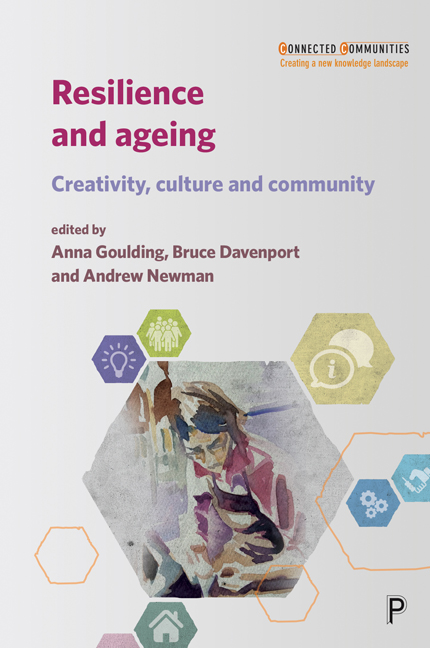Book contents
- Frontmatter
- Contents
- List of figures, tables and boxes
- Notes on contributors
- Series editors’ foreword
- Introduction
- one Setting the field: older people’s conceptualisation of resilience and its relationship to cultural engagement
- two Ages and Stages: creative participatory research with older people
- three Social connectivity and creative approaches to dementia care: the case of a poetry intervention
- four Narrative identity and resilience for people in later life with dementia living in care homes: the role of visual arts enrichment activities
- five After the earthquake: narratives of resilience, re-signification of fear and revitalisation of local identities in rural communities of Paredones, Chile
- six Integrating sense of place within new housing developments: a community-based participatory research approach
- seven Ageing in place: creativity and resilience in neighbourhoods
- eight Crafting resilience for later life
- nine Oral histories and lacemaking as strategies for resilience in women’s craft groups
- ten Objects of loss: resilience, continuity and learning in material culture relationships
- eleven Later-life gardening in a retirement community: sites of identity, resilience and creativity
- Index
nine - Oral histories and lacemaking as strategies for resilience in women’s craft groups
Published online by Cambridge University Press: 19 April 2022
- Frontmatter
- Contents
- List of figures, tables and boxes
- Notes on contributors
- Series editors’ foreword
- Introduction
- one Setting the field: older people’s conceptualisation of resilience and its relationship to cultural engagement
- two Ages and Stages: creative participatory research with older people
- three Social connectivity and creative approaches to dementia care: the case of a poetry intervention
- four Narrative identity and resilience for people in later life with dementia living in care homes: the role of visual arts enrichment activities
- five After the earthquake: narratives of resilience, re-signification of fear and revitalisation of local identities in rural communities of Paredones, Chile
- six Integrating sense of place within new housing developments: a community-based participatory research approach
- seven Ageing in place: creativity and resilience in neighbourhoods
- eight Crafting resilience for later life
- nine Oral histories and lacemaking as strategies for resilience in women’s craft groups
- ten Objects of loss: resilience, continuity and learning in material culture relationships
- eleven Later-life gardening in a retirement community: sites of identity, resilience and creativity
- Index
Summary
Editorial introduction
This chapter is based on an ethnographic study of a women's lacemaking network in Kraków, Poland. As such, the chapter has much in common with Reynold's chapter discussing women's craft activities in the English Midlands. Indeed, this chapter confirms the value of craft work as both a creative and social activity and as contributing to the participants’ resilience. However, it also highlights how the place of creativity is understood in historic craft traditions in a manner that is distinct from understandings of creativity that draw on theatre or fine art. Furthermore, the project reported on here encouraged the women in the lacemaking groups to become amateur ethnographic researchers and advocates for the cultural value of their traditions – processes that had consequences for their identities and resilience.
Introduction
Resilience – when contextualised in relation to older age – can be understood as a process leading to successful adaptation to stresses, difficulties and disturbances associated with ageing and change. It is seen as an important component of ageing and the accompanying decreases in personal autonomy, decline in cognitive functions and coping with the loss of significant others (Tomas et al, 2012). Resilience can be understood as ‘a process of recovery (how well individuals are able to bounce back from adversity), sustainability (the capacity to continue to move forward in the face of adversity), and growth (the ability to further develop as a response to adversity)’ (Manning, 2013, p 569). It is also seen as a ‘dynamic interaction between an individual and his or her social and material environment’ (Janssen et al, 2012, p 344), happening in a particular time and place and in relation with others.
In this chapter, the concept of resilience provides a framework for reflecting upon the ability of individuals to withstand adversities related to old age through engagement in creative craft activity and told through oral stories. The opportunity to express oneself through creative means has been said to promote a sense of control and strengthens social ties (McFadden and Basting, 2010), to create a meaning (life has a purpose) and perseverance (a will to remain involved and active) (Alex, 2010), so that the individuals become more aware and engaged in their everyday life activities.
- Type
- Chapter
- Information
- Resilience and AgeingCreativity, Culture and Community, pp. 203 - 226Publisher: Bristol University PressPrint publication year: 2018



